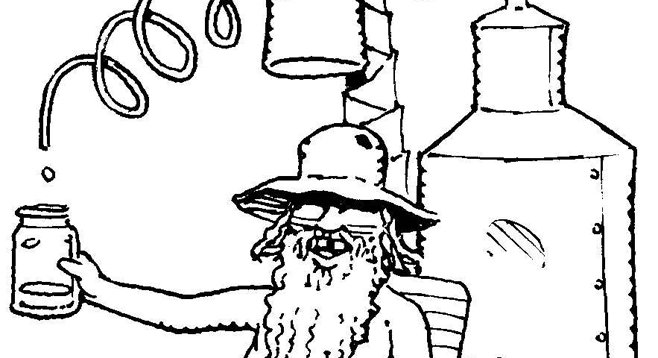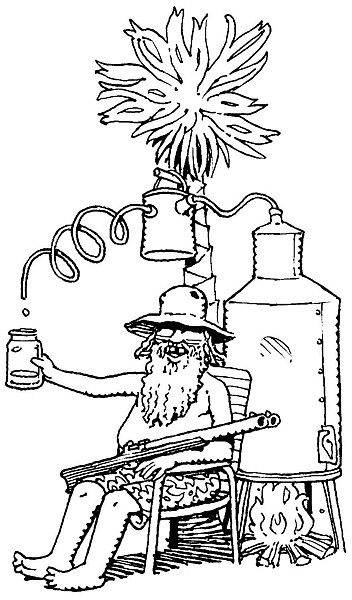 Facebook
Facebook
 X
X
 Instagram
Instagram
 TikTok
TikTok
 Youtube
Youtube

Hey Matt:
This may be a question better suited for Grandma Alice, but I’ve addressed it to you. In making moonshine whiskey I’ve always been told that it is the chemical interaction of yeast with sugar in water that produces the alcohol. If this is so, then what role does the grain, such as corn or barley, play in the final product? Also, is distilling your own whiskey legal in California?
— John Barleycorn

Grandma Alice does indeed have some grandiose Prohibition-era tales of moonshining, but she’s been good enough to share a piece of knowledge or two with me over the years. The ethanol that’s isolated during the distillation process is a by-product that yeast makes when it ferments sugars and other simple carbohydrates. “Sugars” is a somewhat generic term for mono- and disaccharide chemicals, some of which have a sweet taste that you’d recognize. Most common of the tasty sugars are sucrose (table sugar) and fructose (found mostly in fruits and the dreaded high fructose corn syrup). The grains and malts from which whiskey is made contain more than enough sugars to sustain a colony of yeasts. Yeast, being a resilient little fungus, has access to plenty of enzymatic tricks for breaking down complex molecules into the simple sugars it needs to live, which is why it’s not strictly necessary to add sugar to beer or bread. The process of fermentation, along with making alcohol, also produces complex molecules that give all the unexpected flavors to alcoholic beverages. When someone says wine has “hints of black cherry and new car smell,” or whatever, he’s tasting those same flavor compounds.
To answer your second question: distilling your own whiskey — or any other kind of alcohol — has been illegal for ages and probably always will be. Laws that regulate alcohol are convoluted, but you can check out legallibations.com for some clarifications. The major difference in legislating against distillation, as opposed to brewing soft alcohol, is that there’s always been much more inherent risk associated with making hooch in your own still. For example, failing to discard the first run of moonshine, which contains methanol, is what causes the blindness that’s associated with drinking bathtub gin. The worst thing that usually happens when you mess up making wine or beer is you get undrinkable garbage that might make you retch from the flavor but probably won’t do you any real harm. Making matters worse, unscrupulous distillers have added all kinds of toxic substances to their booze over the years and many an innocent tippler has been crippled or killed by poisonous spirits. Bad alcohol can be dangerous even when it’s technically legal. During Prohibition, people used to drink Jamaican ginger extract, called “Jake,” because it was a legal “medicinal supplement” dissolved in a 70 percent alcohol solution. Manufacturers started adding tri-ortho-cresyl-phosphate to the Jake, which turned out to cause horrible neurological symptoms. Drinkers ended up with irreparable nerve damage, causing them to lose control of their feet. For a while, the “Jake walk” was a regular sight on American streets. Because of this and other sad tales of moonshine blues, it’s pretty unlikely that home distilling is ever going to be legal.
Heymatt:
Where did the word “fly,” on the front of men’s trousers, come from? It sure does not tie in with its use.
— Walt, Pacific Beach
Turns out there’s all sorts of cool associations and history for the fly on your pants. It’s definitely not called a “fly” because of its use, although “letting fly” could be a germane verb.
Anyway, the connection becomes a lot clearer when you find out that “fly” comes out of the word “flap,” both of which come out of the proto-Indo-European root word pleu-, which seems to have its genesis in reference to rain. Isn’t it funny to think about Sanskrit and English having a common ancestor? Crazy but true. There also could be some onomatopoeia at work there since “flap” evokes the sound of wings and other flapping things. It looks like “fly” started being used to describe the front of trousers in the 19th Century, most likely borrowed from the term for a tent flap, originally called a “fly.” We still use the word in reference to camping equipment, though only for the specific piece that gets pulled out when it starts to rain; i.e., “quick, put the fly on the tent before we get soaked!” The fly on your trousers got its name from the flappy little piece of cloth that covers the fastening, and the name didn’t originate in reference to the opening itself. Over time, we’ve conflated the two things together and begun referring to the entire apparatus as a fly, which has given us the inspired, “Hey, bro, your fly is down,” or the playground code, “Superman’s flying low.”


Hey Matt:
This may be a question better suited for Grandma Alice, but I’ve addressed it to you. In making moonshine whiskey I’ve always been told that it is the chemical interaction of yeast with sugar in water that produces the alcohol. If this is so, then what role does the grain, such as corn or barley, play in the final product? Also, is distilling your own whiskey legal in California?
— John Barleycorn

Grandma Alice does indeed have some grandiose Prohibition-era tales of moonshining, but she’s been good enough to share a piece of knowledge or two with me over the years. The ethanol that’s isolated during the distillation process is a by-product that yeast makes when it ferments sugars and other simple carbohydrates. “Sugars” is a somewhat generic term for mono- and disaccharide chemicals, some of which have a sweet taste that you’d recognize. Most common of the tasty sugars are sucrose (table sugar) and fructose (found mostly in fruits and the dreaded high fructose corn syrup). The grains and malts from which whiskey is made contain more than enough sugars to sustain a colony of yeasts. Yeast, being a resilient little fungus, has access to plenty of enzymatic tricks for breaking down complex molecules into the simple sugars it needs to live, which is why it’s not strictly necessary to add sugar to beer or bread. The process of fermentation, along with making alcohol, also produces complex molecules that give all the unexpected flavors to alcoholic beverages. When someone says wine has “hints of black cherry and new car smell,” or whatever, he’s tasting those same flavor compounds.
To answer your second question: distilling your own whiskey — or any other kind of alcohol — has been illegal for ages and probably always will be. Laws that regulate alcohol are convoluted, but you can check out legallibations.com for some clarifications. The major difference in legislating against distillation, as opposed to brewing soft alcohol, is that there’s always been much more inherent risk associated with making hooch in your own still. For example, failing to discard the first run of moonshine, which contains methanol, is what causes the blindness that’s associated with drinking bathtub gin. The worst thing that usually happens when you mess up making wine or beer is you get undrinkable garbage that might make you retch from the flavor but probably won’t do you any real harm. Making matters worse, unscrupulous distillers have added all kinds of toxic substances to their booze over the years and many an innocent tippler has been crippled or killed by poisonous spirits. Bad alcohol can be dangerous even when it’s technically legal. During Prohibition, people used to drink Jamaican ginger extract, called “Jake,” because it was a legal “medicinal supplement” dissolved in a 70 percent alcohol solution. Manufacturers started adding tri-ortho-cresyl-phosphate to the Jake, which turned out to cause horrible neurological symptoms. Drinkers ended up with irreparable nerve damage, causing them to lose control of their feet. For a while, the “Jake walk” was a regular sight on American streets. Because of this and other sad tales of moonshine blues, it’s pretty unlikely that home distilling is ever going to be legal.
Heymatt:
Where did the word “fly,” on the front of men’s trousers, come from? It sure does not tie in with its use.
— Walt, Pacific Beach
Turns out there’s all sorts of cool associations and history for the fly on your pants. It’s definitely not called a “fly” because of its use, although “letting fly” could be a germane verb.
Anyway, the connection becomes a lot clearer when you find out that “fly” comes out of the word “flap,” both of which come out of the proto-Indo-European root word pleu-, which seems to have its genesis in reference to rain. Isn’t it funny to think about Sanskrit and English having a common ancestor? Crazy but true. There also could be some onomatopoeia at work there since “flap” evokes the sound of wings and other flapping things. It looks like “fly” started being used to describe the front of trousers in the 19th Century, most likely borrowed from the term for a tent flap, originally called a “fly.” We still use the word in reference to camping equipment, though only for the specific piece that gets pulled out when it starts to rain; i.e., “quick, put the fly on the tent before we get soaked!” The fly on your trousers got its name from the flappy little piece of cloth that covers the fastening, and the name didn’t originate in reference to the opening itself. Over time, we’ve conflated the two things together and begun referring to the entire apparatus as a fly, which has given us the inspired, “Hey, bro, your fly is down,” or the playground code, “Superman’s flying low.”
Comments